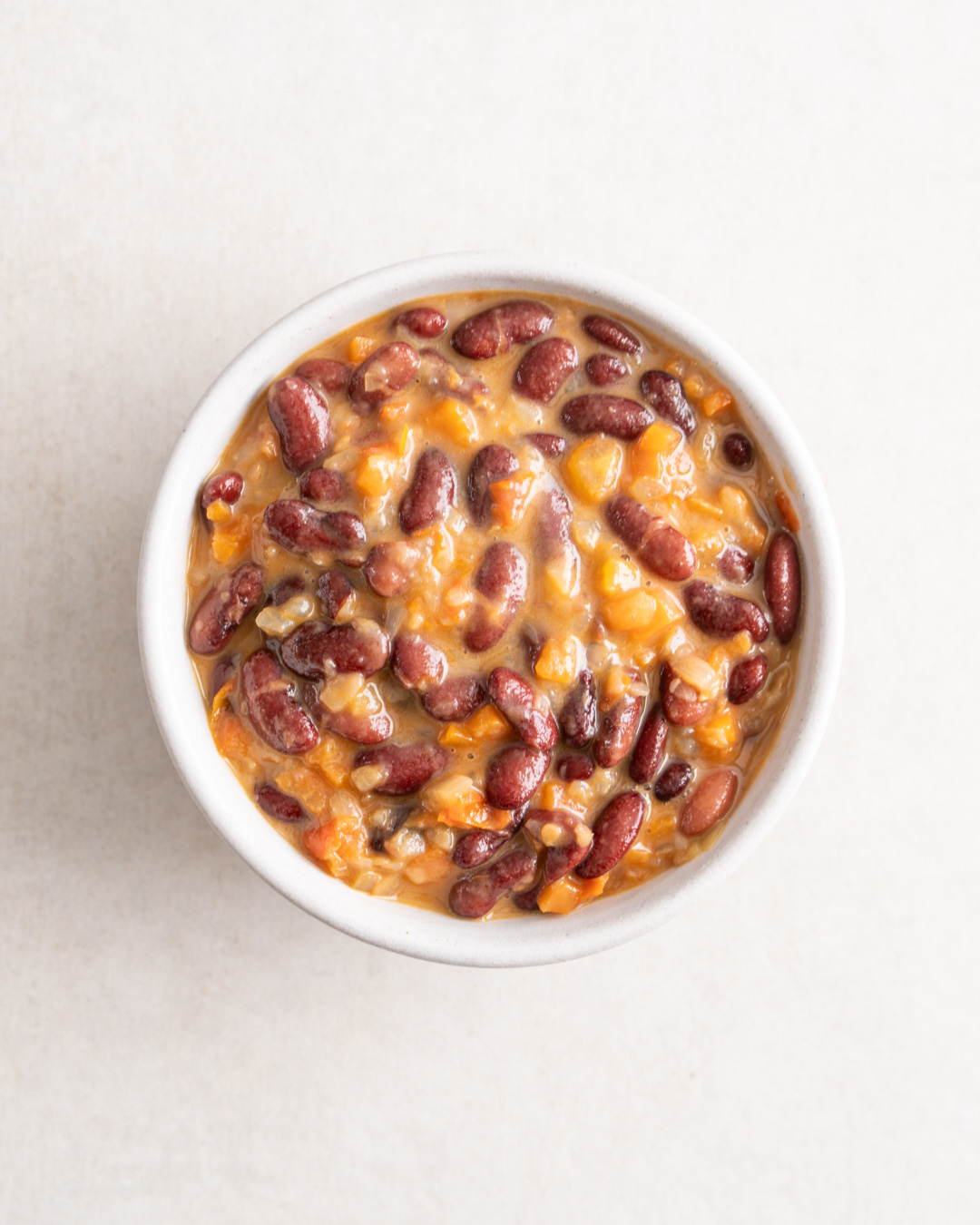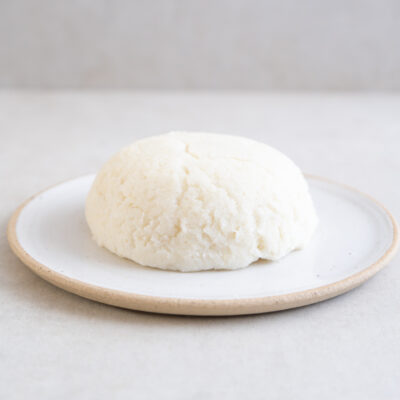Ugali (Tanzanian Maize Meal)

Across the African Great Lakes region, you’ll find versions of Ugali. Most parts of Tanzania and Kenya share the same name for it, with Tanzanian maize meal being a key ingredient, while it’s known as Sadza in Zimbabwe. The Malawian version is called Nsima and was even added to the UNESCO Representative List of the Intangible Cultural Heritage of Humanity.
Interestingly, maize was not a native cereal plant of Africa. It was first introduced by Portuguese traders in the 16th century, before particularly the white varieties were quickly commercialised. When native workers were paid in maize, it eventually entered the local diet and took shape in dishes like Ugali. Today, it’s even considered the national dish of Tanzania and Kenya, where it’s made with Tanzanian maize meal.
Ugali is similar to a very stiff polenta, but made from white maize meal. The process of making it is straightforward, although it requires a bit of a workout in order to smoothen out any lumps while the maize thickens in the pan. It’s usually served in thick wedges, from which smaller pieces are pulled off and shaped into a scoop to mop up whatever it is served with. Undoubtedly, one of the highlights of making fresh ugali are the crispy leftovers that release from the side of the pan as it cools down – a much loved snack with the aroma of roasted corn.
Ugali is traditionally served alongside stews like Mchicha (usually made with amaranth leaves, but spinach is a good substitute) as well as red kidney beans that have been cooked in coconut milk. I’ve added the recipes for both of those side dishes below so that you can serve Ugali as part of a complete meal that is traditionally vegan – and a complete protein (see below).


What is a Complete Protein?
A complete protein contains all nine essential amino acids that the human body cannot produce on its own and must obtain from the diet. Animal-based foods like meat, fish, eggs and dairy are typically complete proteins. However, many plant-based foods lack one or more essential amino acids, making them incomplete proteins.
Some plant foods, such as quinoa, soybeans (tofu, tempeh, edamame), chia seeds, hemp seeds and buckwheat, are complete proteins on their own. Others, like beans, lentils, nuts and seeds, are incomplete but can be combined with other sources to form complete proteins. For example, combining legumes with grains, grains with nuts or nuts with legumes can create a complete protein meal.
Our body can store these amino acids and combine them with those received from sources we consume at other times during the day. So eating a complete protein is not essential for every dish. However, combining different sources of proteins in a single meal makes it easier to cover the daily intake.
serves 4
Ingredients
Ugali
- 450 ml water
- 160g white maize meal / corn meal
Mchicha
- 2 tbsp vegetable oil
- 1 large onion
- 600g amaranth leaves or large leaf spinach
- 2 large tomatoes (300g)
- 3 green finger chillis
- 100g coconut milk
- 75g peanut butter (3 tbsp)
- 1 tbsp Zanzibar curry powder (see below for homemade)
- 1 tbsp salt (14g)
Zanzibar Curry Powder (optional)
- 1 tbsp coriander seeds
- 1 tbsp black mustard seeds
- 1 tsp cumin seeds
- 1 tsp fennel seeds
- 1/2 tsp fenugreek seeds
- 1 tbsp turmeric
- 1/2 tsp ground cinnamon
- 1/2 tsp sweet paprika
- 1/2 tsp chilli powder
- 1 tsp brown sugar
Red Kidney Bean Stew
- 160g dried red kidney beans
- 4 tbsp vegetable oil
- 1 large onion
- 1 large carrot
- 2 large tomatoes (300g)
- 250 ml coconut milk
- 1 1/2 tsp salt (11g)
Method
Ugali
Add the water to a saucepan and bring to a boil, then reduce the heat to medium. Slowly pour in the maize meal, stirring constantly. Continue stirring until it begins to thicken into a dense porridge. At this point, use a wooden spoon to smoothen the mixture against the sides of the pan for 1-2 minutes, or until it pulls away in one big clump as you stir it. This will take more and more effort as the maize meal thickens further, but it will help to remove any lumps.
Spread the mixture out into an even layer, increase the temperature to medium-high and leave it to cook for another 3-5 minutes without stirring. By now, any of the mixture stuck to the side of the pan should begin to break off in flakes, while the edges start to turn slightly golden. Time to remove the mixture. Don’t worry about the layer stuck to the bottom of the pan, it’ll easily come loose later on. For now, just transfer the content of the pan to a bowl, press it down to create an even shape and tip it out onto a plate. Serve warm.
As the pan cools down, you can easily break off the crispy leftovers from the side and bottom and eat them as a snack.
Mchicha
Pre-heat the oil in a casserole. Finely chop the onion and sauté until translucent (8-10 minutes). Meanwhile, finely slice all of the amaranth/spinach and set aside. Roughly chop the tomatoes and finely slice the chillis. In a bowl, mix together the coconut milk and peanut butter.
Add the chillis and tomatoes to the pan and cook until the tomatoes have softened (2-3 minutes), then stir in the curry powder and salt, before adding the spinach along with the coconut milk and peanut mixture. Once the spinach has melted, bring it to a boil and simmer until thickened into a creamy sauce (5-10 minutes). Serve alongside the Ugali.
Zanzibar Curry Powder
Toast the whole spices until aromatic, allow to cool slightly, then grind with the remaining spices into a fine powder.
Stewed Red Kidney Beans
Soak the beans in plenty of water overnight.
The next day, drain them and add to a pan along with 1l of water. Bring to a boil, then simmer for 1 hour or until just tender. Drain and set aside.
When the beans are almost ready, heat the oil in a large sauce pan. Finely chop the onion and dice the carrot, adding both to the pan as you go, then cook until the onion has softened (8-10 minutes). Dice the tomatoes, add to the pan and cook until softened (2-3 minutes). Now tip in the beans along with the coconut milk, salt and 100 ml of water. Bring to a boil and simmer for 15 minutes or until it the sauce has thickened. Serve alongside the Ugali and Mchicha.
As an Amazon Associate I receive a small commission from affiliate links on this page.

Ugali (Tanzanian Maize Meal) + Sides (Optional)
Ingredients
Ugali
- 450 ml water
- 160 g white maize meal / corn meal
Mchicha
- 2 tbsp vegetable oil
- 1 large onion
- 600 g amaranth leaves or large leaf spinach
- 2 large tomatoes (300g)
- 3 green finger chillis
- 100 g coconut milk
- 75 g peanut butter (3 tbsp)
- 1 tbsp Zanzibar curry powder (see below for homemade)
- 1 tbsp salt (14g)
Zanzibar Curry Powder (optional)
- 1 tbsp coriander seeds
- 1 tbsp black mustard seeds
- 1 tsp cumin seeds
- 1 tsp fennel seeds
- 1/2 tsp fenugreek seeds
- 1 tbsp turmeric
- 1/2 tsp ground cinnamon
- 1/2 tsp sweet paprika
- 1/2 tsp chilli powder
- 1 tsp brown sugar
Red Kidney Bean Stew
- 160 g dried red kidney beans
- 4 tbsp vegetable oil
- 1 large onion
- 1 large carrot
- 2 large tomatoes (300g)
- 250 ml coconut milk
- 1 1/2 tsp salt (11g)
Instructions
Ugali
- Add the water to a saucepan and bring to a boil, then reduce the heat to medium. Slowly pour in the maize meal, stirring constantly. Continue stirring until it begins to thicken into a dense porridge. At this point, use a wooden spoon to smoothen the mixture against the sides of the pan for 1-2 minutes, or until it pulls away in one big clump as you stir it. This will take more and more effort as the maize meal thickens further, but it will help to remove any lumps.
- Spread the mixture out into an even layer, increase the temperature to medium-high and leave it to cook for another 3-5 minutes without stirring. By now, any of the mixture stuck to the side of the pan should begin to break off in flakes, while the edges start to turn slightly golden. Time to remove the mixture. Don't worry about the layer stuck to the bottom of the pan, it'll easily come loose later on. For now, just transfer the content of the pan to a bowl, press it down to create an even shape and tip it out onto a plate. Serve warm.
- As the pan cools down, you can easily break off the crispy leftovers from the side and bottom and eat them as a snack.
Mchicha
- Pre-heat the oil in a casserole. Finely chop the onion and sauté until translucent (8-10 minutes). Meanwhile, finely slice all of the amaranth/spinach and set aside. Roughly chop the tomatoes and finely slice the chillis. In a bowl, mix together the coconut milk and peanut butter.
- Add the chillis and tomatoes to the pan and cook until the tomatoes have softened (2-3 minutes), then stir in the curry powder and salt, before adding the spinach along with the coconut milk and peanut mixture. Once the spinach has melted, bring it to a boil and simmer until thickened into a creamy sauce (5-10 minutes). Serve alongside the Ugali.
Zanzibar Curry Powder
- Toast the whole spices until aromatic, allow to cool slightly, then grind with the remaining spices into a fine powder.
Stewed Red Kidney Beans
- Soak the beans in plenty of water overnight.
- The next day, drain them and add to a pan along with 1l of water. Bring to a boil, then simmer for 1 hour or until just tender. Drain and set aside.
- When the beans are almost ready, heat the oil in a large sauce pan. Finely chop the onion and dice the carrot, adding both to the pan as you go, then cook until the onion has softened (8-10 minutes). Dice the tomatoes, add to the pan and cook until softened (2-3 minutes). Now tip in the beans along with the coconut milk, salt and 100 ml of water. Bring to a boil and simmer for 15 minutes or until it the sauce has thickened. Serve alongside the Ugali and Mchicha.
